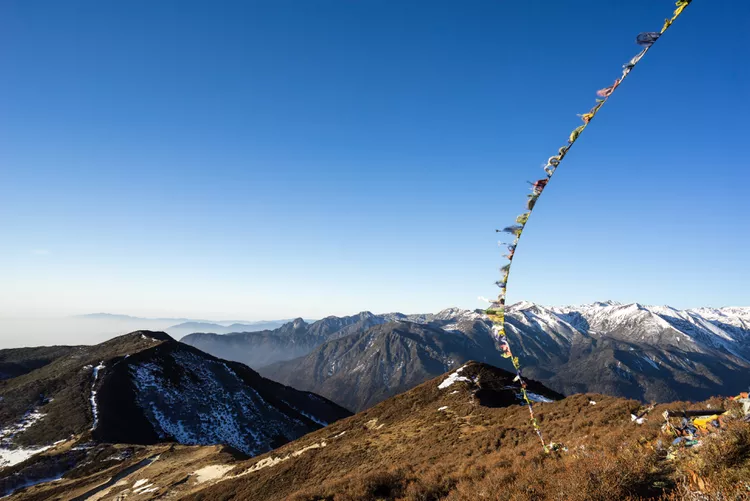Himalayan Adventure of a Lifetime
The classic trek to Dzongri peak (altitude of 13,123 feet) in West Sikkim, India, passes through magnificent rhododendron forests and culminates with the magnificent views of snow-clad peaks at Dzongri. The thrill of Dzongri, the meeting place of man and mountain gods, captures the attention of every adventurer.
When to Visit
The best time to visit Dzongri is from mid-March through April, and then from September to mid-October, allowing you to avoid snowfall and monsoon rains. However, due to the high altitude, there is a possibility of the climate taking unexpected turns at any time of the year.
Getting There
Commence your journey from New Delhi. Take the Indian Railways 12424/New Delhi-Dibrugarh Town Rajdhani Express for a 21-hour trip to New Jalpaiguri. From New Jalpaiguri, hiring a taxi for the six-hour trip to Yuksom, the first capital of Sikkim and the base camp for the Dzongri trek, is recommended.
Trek Arrangements
Yuksom is a small village in Sikkim with a population of about 150, surrounded by stunning mountains. The open roads and views of snow-clad peaks offer a striking contrast to the typically crowded roads of Delhi.
Accommodations in Yuksom are budget-friendly, though expect to share a bath. Ensure you outfit yourself in Yuksom with a guide, cook, and porter while purchasing necessary supplies. Since Yuksom’s economy largely relies on tourism, it is easy to arrange the necessary trekking logistics locally. Additionally, numerous travel agents in Gangtok can assist in organizing the Dzongri trek in advance.
It is essential for all trekkers to register at the police station in Yuksom with valid proof of identity. Furthermore, separate trekking permits are mandatory for foreigners, which can be obtained at tourism offices in Gangtok or Sikkim House in Chanakyapuri, New Delhi.
The Trek
The trek commences from Khangchendzonga National Park in Yuksom. The trek to Dzongri ideally spans five days, including one day of acclimatization at Tshoka village; however, it can be completed in four days if you choose to skip the acclimatization day.
Here’s an overview of what to expect on each of the four trekking days:
- Day 1: Yuksom-Saachen-Bakkhim-Tshokha (11 miles) — The trek to Tshokha passes through dense tropical forests of Khangchendzonga National Park, presenting breathtaking views of mountain peaks amidst the soothing sounds of the river flowing in the valley. The initial five or six miles of the trek are relatively easy, featuring picturesque waterfalls, hanging bridges, and stunning red and white rhododendron flowers. The last few miles, however, are particularly strenuous, with a continuous ascent reaching gradients of 45 to 60 degrees until Tshokha, taking roughly eight hours.
- Day 2: Tshokha-Phetang-Dzongri (5 miles) — This segment of the trek can be challenging as acute mountain sickness may begin to manifest due to altitude. A rest day at Tshokha could assist with acclimatization, so weigh this option before deciding to skip it. The adventure here is heightened by potential rains and snowfalls. While the trail is well-marked with wooden steps, snow can sometimes obscure it, leading to hazards like snowstorms.
- Day 3: Dzongri-Dzongri Peak-Tshokha — This day marks the goal of the trek, and clear weather will reward trekkers with spectacular views of the Kangchenjunga mountain range, the highest peak in the Indian Himalayas, visible from Dzongri Peak.
- Day 4: Tshokha-Yuksom — Retrace your steps back from Tshokha to Yuksom.
Tips
- Money: Carry sufficient cash, as ATMs in Yuksom are notoriously unreliable due to its remoteness.
- Medical care: Acute mountain sickness remains a primary concern on this trek, leading to symptoms such as loss of appetite, headaches, and stomach issues. It is advisable to carry adequate medications since medical facilities are absent during the trek. If symptoms worsen, descending to a lower altitude is crucial. Oral rehydration salts can help avoid cramps due to excessive loss of water and minerals from sweating.
- Clothing: Due to Dzongri’s high altitude, it is prone to unpredictable weather conditions. Invest in quality trekking boots, sleeping bags, raincoats, and heavy woolen clothing for better protection.
- Food: Ample food supplies are critical on the trek. Carry carbohydrate-rich foods, as the low oxygen concentration at high altitudes can slow fat digestion.
- Ecological concerns: Polythene bags are prohibited in Sikkim. Cooperate with authorities and dispose of waste responsibly.
Written with input from Saurabh Srivastava.





